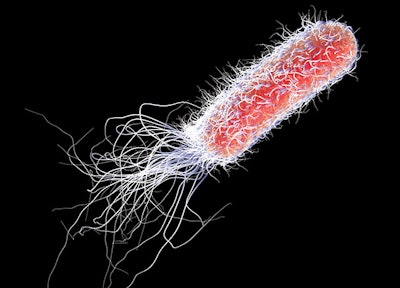
Pseudomonas aeruginosa (abbreviated P. aeruginosa and pronounced sood-o-`mo- nez airoo-gin-o-sa) is a bacterium that causes the majority of skin rashes and infections from pool and spa use. P. aeruginosa is also the cause of most cases of “swimmer’s ear” acquired in swimming pools. It is generally believed that P. aeruginosa rashes are the most common recreational water illness in treated waters.
What It Is
P. aeruginosa is a very common bacterium found in water, soil and on many plants. It can grow on the inside surfaces of PVC pipes used for pool and spa construction and garden hoses used to fill pools and spas. It is adapted to live in water, even when that water is not rich in nutrients.
Common pool and spa sanitizers are effective at killing it, but if a pool or spa is operated without an adequate sanitizer residual, P. aeruginosa can multiply rapidly and reach potentially infective levels overnight. Because it grows faster at high temperatures, it can reach infective levels in spas even more rapidly. P. aeruginosa is one of a group of Pseudomonas species. The other species are not significant causes of water-borne disease.
What It Does
P. aeruginosa is a major cause of skin inflammation and infection (dermatitis and folliculitis, respectively) spread through water. Bacteria from the water attach to the skin and enter in the hair follicles. In the follicles, the bacteria multiply and their waste products cause an inflammation. The affected area may appear as a red, itchy rash or like a burn. The affected area resembles a chemical rash (contact dermatitis). The areas of the body most frequently affected are the groin, the armpits and the area covered by the swimsuit.
The incubation period of rashes varies from 1 to 10 days. Because of the long incubation period, some cases are misdiagnosed as chemical rashes rather than bacterial infections. Most cases of dermatitis and folliculitis are not diagnosed properly and are not reported.
P. aeruginosa is also major cause of “swimmer’s ear” (otitis externa), which is the inflammation of the portion of the ear from the tympanic membrane (eardrum) outward. Not all cases of otitis externa are related to pool and spa use. Otitis externa is the most frequent cause of infant and toddler visits to the doctor.
Individual susceptibility and the type of activity pursued are factors determining whether an infection will occur. Periods of swimming underwater and diving increase the possibility of infection. P. aeruginosa is also a cause of pneumonia in cystic fibrosis patients, cornea infections in contact lens users and systemic infections among IV drug users.
It is also a major cause of urinary tract infections, surgical infections and wound infections in burn patients. These are very serious infections that may be life threatening if not properly treated. These infections have not been proven to be associated with the use of pools and spas. Because of the potential for infection from P. aeruginosa and other water-borne diseases, immuno-comprised individuals and individuals with broken skin should be cautious in using pools and spas where the history of proper sanitation is unknown.
RELATED: Ozone vs. Cryptosporidium: Fighting a Wave of Outbreaks
Prevention and Precautions
A. Prevention
Nearly all water-borne infections can be prevented by the proper maintenance of an EPA-registered sanitizer. The sanitizer level should be maintained at recommended levels at all times. If the sanitizer level is allowed to remain low for extended periods of time, infestation may occur and water treatment should be initiated before use by bathers.
Sanitizers displaying an EPA registration number on the label have demonstrated effectiveness for the control of bacteria.
B. Precautions
Pools and spas not maintained according to proper guidelines should be treated before use. This is especially important for pools and spas that have not been treated for a week or more. After treatment with the sanitizer, the pool or spa should be allowed to circulate thoroughly. In the case of pools, circulate the pool overnight. With spas, circulate at least 30 minutes after treatment and before entry. Circulation of the water in both the filtration and booster pump systems allows the sanitizer to kill bacteria in the water and to treat bacteria that have begun to grow in the plumbing.
Many water treatment methods suggest periodic shock treatments. Products labeled as shock-oxidizers should not be used to kill or control germs. Products labeled as shocks both kill germs and oxidize contaminants. Do not substitute shock treatments for maintaining an adequate sanitizer treatment.
Periodic cleaning of the filter is strongly recommended — follow the manufacturer’s recommendations. Improperly maintained filters have been shown to be a major source of bacteria outbreaks. Note that filter-cleaning compounds are not designed to kill bacteria, but cleaning the filter will increase the potential of the sanitizer to control bacteria.
C. Decontamination
In case of suspected bacterial infestations, decontaminate the pool or spa. Infestations are gross contaminations of the system. Infestations described here are rare and not associated with well-maintained systems. Some signs of possible infestation include slime formation (especially in spas), cloudy water, musty odors, bather rashes and flu-like symptoms suspected to have originated from spa use. Any incidents of fecal or vomit contamination require immediate decontamination. Decontamination guidelines are available from APSP.
D. Medical Treatment
If rashes or ear infections are suspected, seek medical attention. Severe infections may cause scarring or lead to other more serious secondary infections. Most mild cases of P. aeruginosa skin infections run their course and resolve themselves in less than two weeks without medical treatment. Approximately 5 percent are major medical events that require intravenous antibiotics. After an outbreak, it may not be possible to culture live P. aeruginosa from the suspected water source. Correct diagnosis requires culturing the infected follicles and the recovery of P. aeruginosa from the exudate.
RELATED: E. coli: Waterborne Health Risk











































